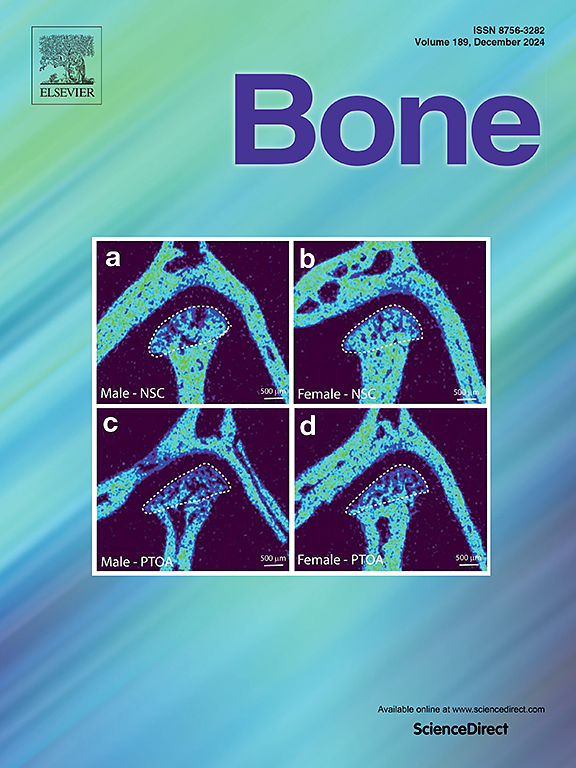基于dxa的三维有限元模型对老年女性髋部骨折的预测优于实际骨密度
IF 3.5
2区 医学
Q2 ENDOCRINOLOGY & METABOLISM
引用次数: 0
摘要
骨强度是骨折风险的主要因素。通过双能x线吸收仪(DXA)获得的面骨矿物质密度(aBMD)被用作骨折风险预测中骨强度的替代指标。三维有限元(FE)模型预测骨强度比aBMD更好,但需要三维计算机断层扫描,而且不是自动化的。我们之前已经开发了一种方法,可以从2D髋关节DXA图像自动重建3D髋关节解剖结构,然后根据受试者特定的fe预测股骨近端强度。在这项研究中,我们评估了该方法在以人群为基础的女性队列(OSTPRE)中预测髋部骨折事件的能力。我们使用了一个亚队列,包括46例髋部骨折病例(从DXA扫描算起10年)和2例健康对照,每个髋部骨折病例按年龄、身高和体重指数相匹配。我们自动重建了三维髋关节解剖结构,并使用FE分析预测了所有亚队列受试者的股骨近端强度。fe预测股骨近端强度比aBMD更能预测髋部骨折的发生(受试者操作特征曲线下面积差异,ΔAUROC = 0.10)。这是第一次在以人群为基础的前瞻性随访女性队列中,通过2D髋关节DXA扫描获得的3D FE模型在预测髋部骨折事件方面优于aBMD。我们的方法以临床可行的方式(只需要一张DXA图像)提供了改进的骨折风险预测,与目前的临床方法相比,没有额外的成本。本文章由计算机程序翻译,如有差异,请以英文原文为准。
DXA-based 3D finite element models predict hip fractures better than areal BMD in elderly women
Bone strength is a major contributor to fracture risk. Areal bone mineral density (aBMD) obtained from dual-energy X-ray absorptiometry (DXA) is used as a surrogate for bone strength in fracture risk prediction. 3D finite element (FE) models predict bone strength better than aBMD but need 3D computed tomography and are not automated. We have earlier developed a method to automatically reconstruct the 3D hip anatomy from a 2D hip DXA image, followed by subject-specific FE-based prediction of proximal femoral strength. In this study, we evaluate the method's ability to predict incident hip fractures in a population-based cohort of women (OSTPRE). We used a sub-cohort including 46 cases with a hip fracture (<10 years from DXA scan) and 2 healthy controls to each hip fracture case, matched by age, height, and body mass index. We automatically reconstructed the 3D hip anatomy and predicted proximal femoral strength using FE analysis for all the subjects of the sub-cohort. The FE-predicted proximal femoral strength was a significantly better predictor of incident hip fractures than aBMD (difference in area under the receiver operating characteristics curve, ΔAUROC = 0.10). This is the first time that 3D FE models obtained from a 2D hip DXA scan outperform aBMD in predicting incident hip fractures in a population-based prospectively followed cohort of women. Our approach provided an improved fracture risk prediction in a clinically feasible manner (only one single DXA image is needed) and without additional costs compared to the current clinical approach.
求助全文
通过发布文献求助,成功后即可免费获取论文全文。
去求助
来源期刊

Bone
医学-内分泌学与代谢
CiteScore
8.90
自引率
4.90%
发文量
264
审稿时长
30 days
期刊介绍:
BONE is an interdisciplinary forum for the rapid publication of original articles and reviews on basic, translational, and clinical aspects of bone and mineral metabolism. The Journal also encourages submissions related to interactions of bone with other organ systems, including cartilage, endocrine, muscle, fat, neural, vascular, gastrointestinal, hematopoietic, and immune systems. Particular attention is placed on the application of experimental studies to clinical practice.
 求助内容:
求助内容: 应助结果提醒方式:
应助结果提醒方式:


